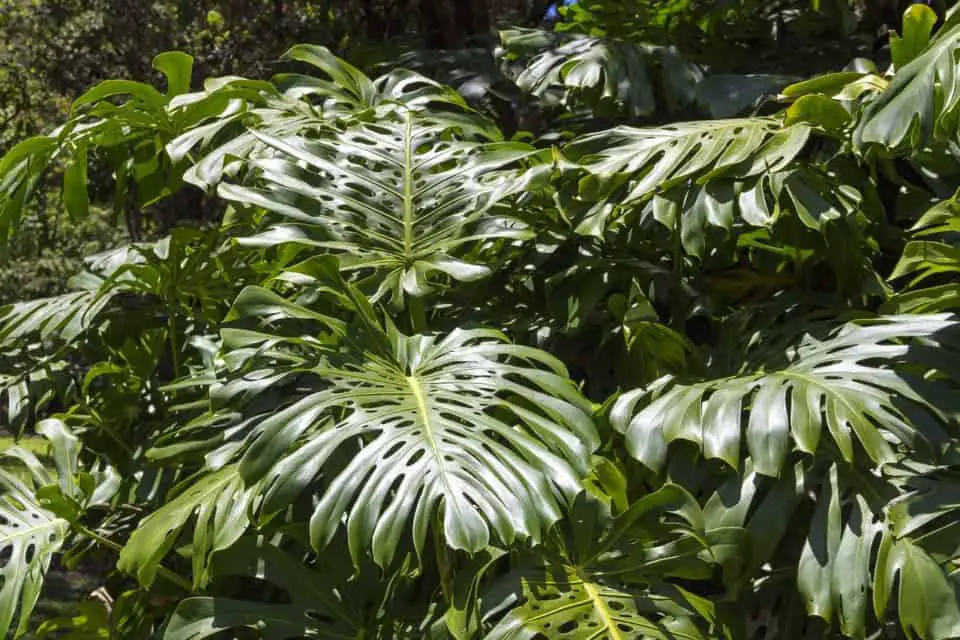Some links in the post are affiliate links and I get a commission from purchases made through some links found in the post.
The philodendron is a rare beauty to behold and one that makes any space remarkable when it comes down to aesthetics.
It gets even better when you grow it in water, as this enables you to take in the beauty of its trailing vines.
All you need is a transparent jar or vase to get started on what can easily be the centerpiece in any room. Are you ready to get started? For a quick guide on how to propagate your Philodendron.
Make a cutting from a healthy Philodendron by snipping at least three inches of a vine with nodes. Then place your cutting into fresh water in a container, making sure the nodes are submerged.
Then make sure the philodendron is in indirect sunlight and you change the water every few days. After a few weeks the roots should be developed enough to transplant your philodendron.
Let’s propagate philodendrons in water!
The Origins of the Philodendron
 The philodendron is native to America, and for this reason, adapting it to your indoors should not be much of a hassle, if any.
The philodendron is native to America, and for this reason, adapting it to your indoors should not be much of a hassle, if any.
Again, this depends on where you live. But not to worry. We will cover its growing conditions in detail to help you cater to its needs.
It boasts of glossy green leaves that make your indoors feel and look tropical. And for a more appealing look, how about you opt for a climbing variety?
It can creep along your walls and add to the greenery in the home. We all know how much this look has become popular over the years.
If this does not appeal to you, going with an upright variety can help. This option works best as a centerpiece for any room.
PS: The best philodendron varieties to grow in water are heart leaf philodendron and velvetleaf vine.
However, you are always free to work with other options. It helps to note that this article focuses on these favored varieties.
How to Propagate Philodendrons in Water
Other than growing this beauty in soil, you also have the option to propagate your philodendrons in water.
On the upside, this does away with the need to pot and repot the plant as it gets bigger (you know the drill with rootbound plants).
Also, you get to avoid dealing with unsuitable soil types, drainage issues, and other problems you might come across in soil-propagated plants.
If you ever decide to grow it in soil, philodendrons will be hardy enough to withstand the challenges that come with this propagation mode.
As such, growing it in water is not a disservice to its thriving. Sounds good?
The instructions are pretty straightforward to propagate philodendrons in water, and this article will walk you through each step.
Step by Step Guide on Propagating Philodendrons in Water
The first step to propagate philodendrons in water is to making a cutting.
For this, you will need shears, a scalpel, or scissors. Choose anything that will ensure you get a clean cut to avoid damaging the mother plant with blunt cuts.
Also, a clean-cut will give rise to a healthy vine that will grow fast. Make sure you sterilize the tool before using it on the mother plant.
Snip at least three inches of a vine with nodes from a healthy Philodendron.
The vine you choose plays a huge role in how healthy the resultant plant will be, and you need to make a good choice in this regard.
The good news is that you can even use a days’ old vine to grow yours. To get it right, start by selecting a healthy plant, the healthiest if you can.
The vine should be free of diseases and pests and should exhibit healthy growth. This type will grow fast and will enable you to get the desired bush.
As much as you can use any vine, it should not be too old or too young. Younger vines may have a hard time establishing, more so with the shock that comes from cutting.
On the other hand, older ones may give you a hard time when it comes to sprouting.
Try and strike a balance by going with a vine that lies between these extremes. If you want more sprouts, inch closer to the older vines.
Make a clean cut. Rooting will start where you make the cut, and you want to give the vine the best chances of a healthy sprout.
As such, be wary of any blunt cuts that could pave the way for root rot diseases.
Depending on how bad the cut is, the vine may not sprout. Use a sharp tool as earlier indicated to get a clean and fast cut.
While it is not mandatory, you should work with a vine with a node in the cutting. It betters your chances of success, but if you cannot find one, no worries. It will work just fine.
You may also like: What is the rarest philodendron
Dip your Philodendron in Warm Water
You can now dip this vine in a vase with warm water. The vine does not require any special prepping instructions, and you can dip it in the water as it is.
For this, you will need a vase, glass, or any other container that can hold a plant the size of which you desire.
Also, keep in mind that the container’s size will play a vital role in placing it and how much care you will need to give the plant.
While you do not have to do so, getting a beautiful vase will go hand in hand with the philodendron’s beauty. It’s something you might want to consider.
The water in the container must be adequate to support the growth of a healthy bush. Moreover, it must be free of any chemicals that might hamper the growth of the plant.
Please note that you will need to change the water often; else, the plant could die from infestations or other problems.
Water Quality
 Another point to add here- choose where you will be getting your water when you propagate philodendrons.
Another point to add here- choose where you will be getting your water when you propagate philodendrons.
The water quality must remain consistent unless you come across a situation where the water does not support the plant as needed.
If you decide to work with rainwater, that will be your go-to. As such, do not choose a quality you cannot sustain in the future.
The best option is rainwater as it does not have chemicals such as fluorine and still has enough nutrients to support the plant’s growth.
While filtered and boiled options can also suffice, they may lack enough nutrients to support the plant’s growth.
Change the water once every week to ensure it remains fresh.
Place the Container Under Indirect Bright Light
Light
While the plant should not be in direct light, you will notice its tendency to move towards the direction of light.
As the vine sprouts and grows into a beautiful plant, you will need to keep rotating it to ensure all sides get access to light.
Under no circumstances should you place it in direct sunlight. Doing so would only scorch its glossy leaves, taking away from its appearance.
Plus, the leaves can start yellowing, leading to the eventual death of what could have been a sight for sore eyes.
Temperature
As for the temperature, the plant does best in ranges between 65ºF and 85ºF. That is not to say that it cannot do well in temperatures lower or higher than this range.
It can withstand temperatures as low as 50ºF and as high as 95ºF. Thus, when winter and summer come around, you will need to keep this in mind and make necessary changes.
Sometimes, you may have to move it to a cooler or warmer region.
Now, here is the thing with temperature. Low temperatures will cause the plant to stunt and get in the way of the delightful bushy growth.
High temperatures are not suitable either as these interfere with the aesthetics of the plant. Plus, you will need to keep changing the water to keep up with the high evaporation rates.
Drastic changes can also affect the plant’s growth, and you will want to ease your plant into any new conditions in the home.
Humidity
Your plant will do best in a humid location. The good thing is that the plant will be in the water, which will cover its humidity needs without much work on your part.
However, the positioning of the plant determines how much added humidity will be necessary.
If you’re going for a flowing look where the plant leaves and stems drop down from a container, you will need to mist the plant.
But if the plant is growing upright, the evaporating water will do the trick, and you can do without the misting.
If you are enjoying this article, check out our article on can philodendron grow in shade.
Trim and Prune the Plant to Achieve the Desired Shape
You will soon notice that your plant will look for places to attach and may want to take over the entire space.
Pruning will be necessary to keep you from losing your home to the philodendron! This way, you can also get vines to propagate in other locations in your house, as we earlier saw.
Pruning can occur at any time of the year, and you do not need to wait for a given season. Given how fast this plant grows, the sooner you get to it, the better.
To train the plant, you can use hooks on the walls or any other materials to help you curb its spread.
How Long Does it take Philodendron to Root in Water?
The roots of a philodendron should show within a week or two.
If you want to move the plant to the soil, wait about a week after rooting to give them a higher chance of survival when moved.
How do you Encourage your Philodendron Roots to Grow?
The plant should do well in water as it is a light feeder, and the nutrients in water should be enough.
However, if you choose to add some fertilizer, you can work with a liquid option. Be careful not to overfeed the plant as this can burn the roots and cause even more stunted growth.
An easier way to encourage growth is to make sure the plant has the required conditions as earlier indicated and choosing the right cutting from the beginning.
Can you Grow Philodendrons in Water Permanently?
There is no reason you would need to move the plant to soil other than preference.
The water will provide a suitable growing mechanism and will rid you of the hassle of dealing with root rot and whatnot.
Repotting is hardly necessary either. It is quite rare to come across such roots having outgrown the container.
It partly owes to pruning and the regular water changes that keep their growth in check. But if you want to change the appearance of the container, you can move the plant.
It is as easy as moving the plant to another container the next time you change its water.
Is it Better to Propagate in Water or Soil?
 It comes down to the plant in question and your preferences as far as maintenance needs go.
It comes down to the plant in question and your preferences as far as maintenance needs go.
In the case of the philodendron, the plant does very well in water and can grow so without soil. Plus, its maintenance needs are breezy, taking a lot of work off your hands.
You can as well move it to the soil, but this comes with some challenges such as easier contamination and the need for regular repotting.
To make sure your plant does well, keep an eye on the water level in the container. The plant will use a lot more water than it would when growing in soil.
Anytime the water is just above the roots, you should add some more to prevent the roots from getting exposed to the elements and dying.
Before you go, here are some more related articles I encourage you to read below to help solve more of your gardening issues:
Can I grow ferns in water only?
How to fix your Philodendron Selloum problems
Why is my Philodendron Brasil Dying
How to Care for a Philodendron Tiger Tooth
What are the Benefits of Having a Philodendron
How to Care for a Philodendron Over Winter
Can a Philodendron be put Outside
Happy Gardening!

